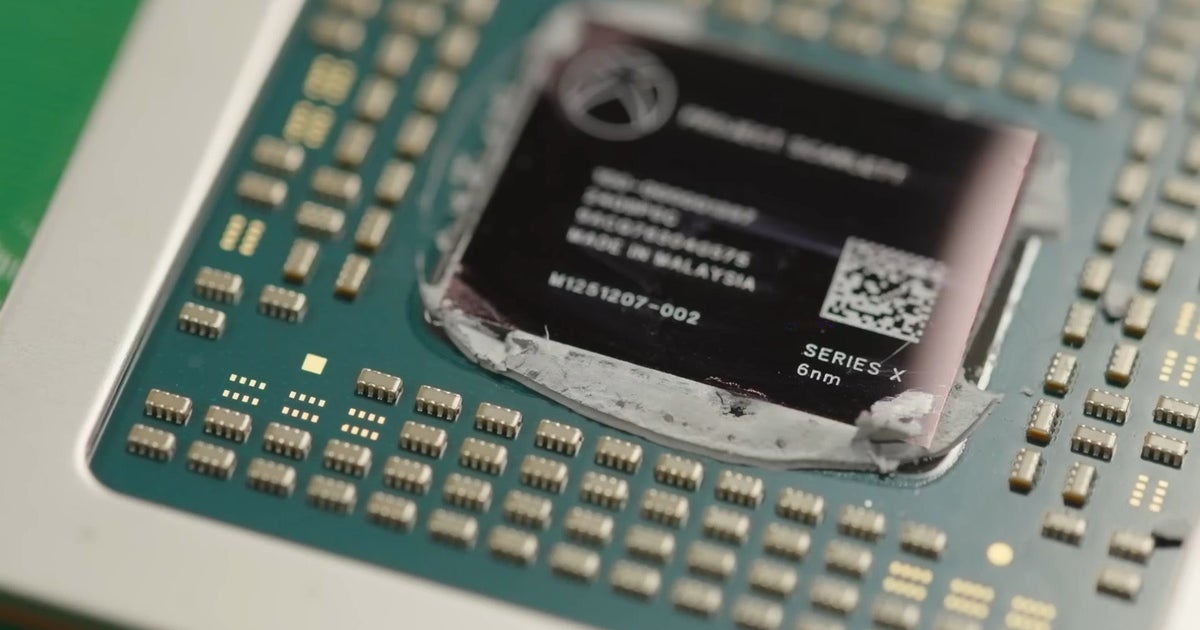“Series X 6nm! YESSSSSS! We found it!” Not my words, but the excited exclamations of Austin Evans, with a brand-new video that tears down the new disc-less edition of the Xbox Series X, revealing what’s generally believed to be the first major console revision for Microsoft since 2020. It’s an interesting contrast with Sony, who have revised the PlayStation 5 annually, moving to a 6nm processor way back in 2022 and delivering a further-revised ‘Slim’ edition a year later. 6nm silicon brings with it apparent cost-reductions and efficiency improvements – but this is no game-changing update in the way it was with the Xbox One S and the PS4 Slim. In concert with a $599 Xbox Series X 2TB, a $449 disc-less Series X and a $699 PlayStation 5 Pro, the days of console cost-reductions are clearly over and the whole nature of what next-gen will actually be is up for debate.
Going back to the Austin Evans video, the nature of the Series X revision is fully revealed. By moving from 7nm to 6nm, the chip itself is smaller. Evans is seen measuring the processor but doesn’t offer a die-size. Having spoken to him, his measurements for the older chip don’t meet the acknowledged 360mm2 (it’s more like 380mm2), but comparing his measurements for the new chip to the old, it’s around 87 percent of the size. This would suggest a 6nm die-size of around 313mm2. Truth is, package size and die size can be slightly different, perhaps explaining the discrepancy in measurements. Even so, the size reduction is broadly in line with PS5’s shrinkage, with similar, modest power consumption improvements up against the prior 7nm models.
Thanks to this, Microsoft follows Sony in also reducing the quality of the cooling assembly. The impressive heft of the old cooler with its vapour chamber is swapped out for a more conventional design with copper heat pipes. While internal temperatures aren’t measured in the Evans video, the end result is a console that basically looks very similar to the old one, and has a similarly quiet acoustic profile. Sony took the opportunity to build a new form-factor around its efficiency improvements, but Microsoft has not. Despite the emergence of the trash can-like, adorably all-digital Xbox Series X in Microsoft’s self-leaked FTC disclosures, it’s clear that the current form-factor remains the same.
- 0:00:00 Introduction
- 0:00:59 News 1: New Series X has 6nm SoC, revised internals
- 0:18:08 News 2: Xbox Partner Showcase reveals new games
- 0:38:36 News 3: Analogue 3D announced!
- 0:49:38 News 4: Halo battle royale game was cancelled
- 0:59:18 News 5: Tomb Raider 4-6 remasters announced
- 1:10:58 News 6: 3GB GDDR7 memory modules announced
- 1:17:16 News 7: Killing Time: Resurrected released
- 1:27:34 Supporter Q1: Will PS5 Pro have an expanded VRR range? When will we see the Ultra Boost Mode? And can it unlock frame-rates without developer intervention?
- 1:34:54 Supporter Q2: What type of CRT tube does John prefer?
- 1:38:40 Supporter Q3: What would need to change for an Nvidia powered Xbox or PlayStation to happen?
- 1:44:45 Supporter Q4: Could PS6 skip PS4 backwards compatibility?
- 1:48:53 Supporter Q5: What do you think of the ModRetro Chromatic?
- 1:52:16 Supporter Q6: How should we view AI-powered visual modifications to games?
- 2:01:20 Supporter Q7: Does AMD regret the 5800X3D?
In this week’s DF Direct, a Supporter asks us why it took so long for Microsoft to produce a new Xbox, bearing in mind Sony embraced 6nm two years ago – and the Series X has a markedly larger processor, meaning a potentially higher cost saving. We’re also asked why the power saving isn’t more pronounced than PS5’s, bearing in mind the larger chip. Well, on the latter point, PS5 and Series X at 7nm consumed similar power so it stands to reason it’s the same situation at 6nm too. Microsoft’s chip might be larger, but Sony’s is pushed to higher clocks – on the GPU side at least.
As for why it has taken Microsoft so long to shrink the Project Scarlett SoC, this moves us into the kind of economic decision-making nobody outside of the console manufacturers really has visibility on. We can only assume that these companies are not in the business of needlessly throwing money away and that the decision is sound. There are any number of reasonable theories that might fit: Microsoft may simply have had a larger stockpile of chips, for starters. We just don’t know.
The bigger story is the fact that outside of localised discounts, this particular mid generation cost reduction is not like any other before it. Moving the main processors to lower process nodes was a routine practise during the PlayStation 3/Xbox 360 era, with many different revisions available. Both consoles went through three visible form-factor revisions, but the chips were improved even more frequently than that. PS4 and Xbox One? There was only one process reduction across the entire generation. The 2013-era 28nm process yielded to 2016’s 16nmFF, offering huge efficiency improvements, striking form-factor revisions and opening the door to the mid-gen ‘Pro’ consoles: Xbox One X and PS4 Pro.
Compare and contrast with the 7nm to 6nm transition: more a step than a leap, with no game-changing reductions to processor size, heat reduction or efficiency – more of a modest ‘nice to have’ series of improvements. Microsoft clearly ‘did the maths’ and realised that a mid-gen enhanced console was not a good idea. Sony, who already had more latitude thanks to PS5’s smaller chip vs Series X, decided it was worth doing – even if the end result is a $699 console. I’d still take it over a $599 Series X 2TB (even if it does have the disc drive the Pro lacks) but the latitude to make affordable console hardware is clearly not there if neither platform holder can actually make it. All of which asks serious questions of next-gen, a topic I’ve covered before.
Enter ex-Sony CEO Shawn Layden, who reckons that the console arms race has now played out: “It has plateaued. We’re at the stage of hardware development that I call ‘only dogs can hear the difference’. If you’re playing your game and sunlight is coming through your window onto your TV, you’re not seeing any ray tracing. It has to be super optimal, you have to have an 8K monitor in a dark room to see these things. We’re fighting over teraflops and that’s no place to be. We need to compete on content. Jacking up the specs of the box, I think we’ve reached the ceiling.”
Many will agree with Layden – certainly the legions of PS4 and Xbox One owners who’ve felt no need to upgrade their consoles, based on the sparse numbers we have on Sony and Microsoft’s player bases stacked up against their console sell-in numbers. However, this does stand in contrast to the rampant success of Nvidia in particular in the PC space, where the RTX stands triumphant and where the ray tracing and AI features of those products have clearly found an audience. RTX 40 series in particular has gained ground in a way that isn’t compatible with our own expectations from the price-rises we saw there. It’s particularly amazing to me to see that arguably the poorest value 40 series GPU – the 4060 Ti – sits proudly in fourth spot in the Steam Hardware Survey as of this writing.
Where I concur with Layden is that content is always king – something proven out once again by Nintendo Switch – but new technology is a key enabler for fresh gaming experiences and I’d say that Nintendo agrees too, based on what we know of Switch’s design. In fact, between Nvidia, Intel, AMD, Sony, Microsoft and Nintendo, it’s clear that future innovation will be based on refinements to today’s technology, augmented with more powerful RT and machine learning features. The direction of travel is essentially set in stone at this point, but delivering it at a palatable price-point is the key challenge.
fbq('init', '560747571485047');
fbq('track', 'PageView'); window.facebookPixelsDone = true;
window.dispatchEvent(new Event('BrockmanFacebookPixelsEnabled')); }
window.addEventListener('BrockmanTargetingCookiesAllowed', appendFacebookPixels);











Leave a Reply